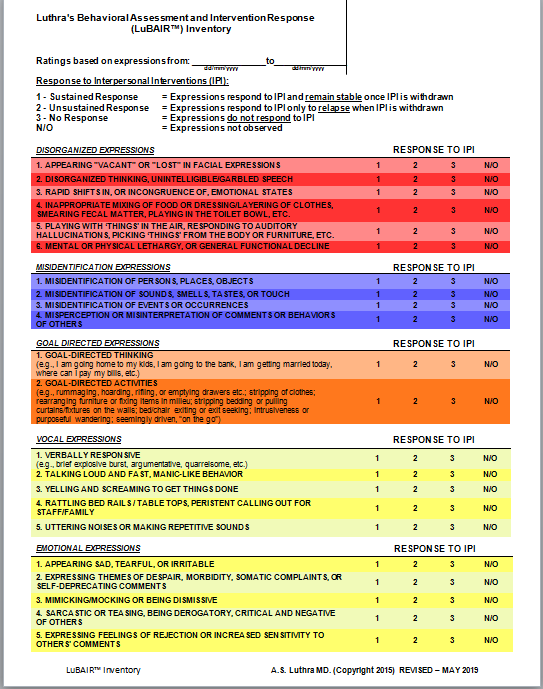Luthra’s Behavioral Assessment and Intervention Response (LuBAIR™) Inventory.
Reliability and Validity Study.
Each of the twelve newly appointed behavioral categories derived from the SCRB model was used to create a behavioral assessment tool for assessing behaviors in patients with moderate to advanced Dementia/Major Neurocognitive Disorders (D/NCD). This inventory is titled LuBAIR™: Luthra’s Behavioral Assessment and Intervention Response Inventory.
LuBAIR™ Inventory has been evaluated against existing reliable and valid behavioral assessments, inclusive of the Cohen-Mansfield Agitation Inventory (CMAI) and BEHAVE-AD. LuBAIR™ Inventory was determined to have comparable reliability and validity, is more comprehensive in data collection, and allows for behaviors to be categorized in clinically meaningful ways thereby allowing for an understanding of the meaning for the presence of behaviors. These results have been compiled into a manuscript which can be viewed here.
How to use the LuBAIR™ Inventory
Step 1: Review clinical records of the patient referred for evaluation and identify all behavioral symptoms documented. Match each identified behavioral symptom to the most appropriate behavioral category on the inventory. This step identifies the Quality of behaviors present in the index patient.
Step 2: Follow the identified Quality of behaviors over the subsequent week to determine the Severity of each Quality of behavior. With LuBAIR™ Inventory, behavior Severity is determined by the response of each behavior to interpersonal interventions (IPI). Severity is rated as (1) if the patient responds to IPI (sustained response to IPI), (2) if they initially respond to IPI but relapse once IPI is withdrawn (unsustained response to IPI) and (3) if they do not respond to IPI at all.
Step 3: Transfer the identified behavioral categories onto a Dementia Observational Scale (DOS) (also referred to as the Q15 minute observation scale). This will provide the Frequency and Duration of each identified Quality of behavior.
Using LuBAIR™ Inventory in clinical practice results in behaviors being evaluated along the following constructs:
- Quality of behaviors
- Severity of behaviors
- Frequency and Duration of behaviors
Future Direction

The next step in

Hi Dr Luthra
Very interesting tool and piece of research.
I’ve ordered the book via Amazon and looking forward to discover more.
I’m a Dementia Care Practitioner(non clinician) in the UK. However I’m so passionate about dementia and associated behaviours
Your book brings some reasoning.
Kind regards
Patricia